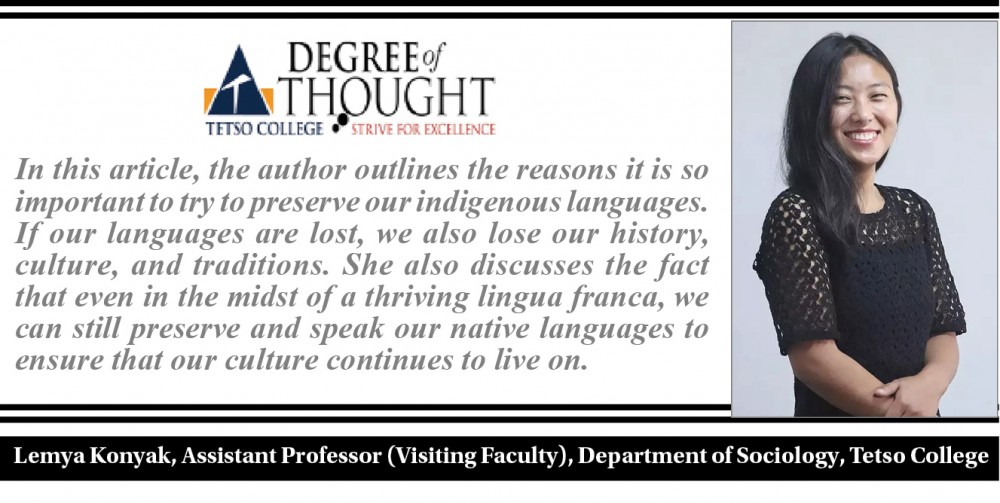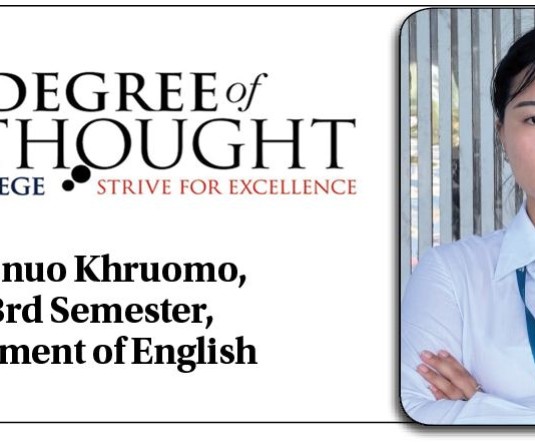
Lemya Konyak, Assistant Professor (Visiting Faculty), Department of Sociology, Tetso College
An indigenous language, according to the Vocabulary.com dictionary, is defined as a language that originates in a specific place and is not brought to a place from elsewhere.
Nagaland, a state located in the northeastern parts of India, is considered a land of myriad languages and cultures. And it can be considered a fertile land for linguistic study. According to the 2011 census, Nagaland effectively has fourteen languages and seventeen dialects, with the largest language (Konyak) having a share of 46% (Shashidhar, 2018). The state of Nagaland has a rich linguistic legacy and is regarded as having the most linguistic diversity. The languages spoken by the Nagas are grouped under the Tibeto-Burman language family. The state has a rich linguistic tradition that has served as a treasure trove of knowledge for its people. The sixteen recognised tribes in Nagaland down the history line have preserved their indigenous languages, which have been usually passed down through oral narration from one generation to another.
With the advancement and civilization of today, we see that the Naga society has adopted English and Nagamese as the lingua franca, which are becoming dominant languages within the state and taking over the indigenous languages of each tribe. Nagamese, which is a kind of Pidgin Assamese developed initially as a market language to communicate among the various tribes, has emerged as a threat to the Naga indigenous language today. It is said that Nagamese is one of the fastest-growing languages in the state. On the other hand, the English language, which is known as the state's official language, gained ground in 1967 when the Nagaland Assembly proclaimed "Indian English'' as its official language. Since English is the official language and medium of instruction in all institutions, it gained ground in a short period of time. Today, it is a threat to the indigenous language, making it a huge area of community concern.
The ground reality is that the younger generation have made English and Nagamese their main priority languages and have failed to acknowledge the indigenous languages. Using and communicating through a lingua franca is considered a source of pride and has found a place in society, while many appear to be least bothered even when one does not know how to speak in one’s indigenous languages. It is obvious from this that one can predict that indigenous languages are on the path towards endangerment. Ayesh Kidwai, a prominent linguist from India, said, "With the loss of language comes the loss of everything in a culture and the loss of solidarity, the loss of man himself" (cited in Mohanty, 2020). If we continue to be ignorant of the danger that lies ahead, one day we may lose our indigenous languages, our culture, and ourselves.
What we see today is that in urban areas and within families themselves, parents and children are more comfortable conversing in English or Nagamese than in their indigenous language, which has also made the younger generation converse in their indigenous language. Thus, children cannot be expected to converse in their indigenous languages beyond the domain of their household as well. The basic unit of society, i.e., the family, has drifted away from its function to teach the children the importance of indigenous languages. Even in religious institutions, the indigenous language-speaking churches are now losing their congregation and the independent churches are growing, especially since the younger generation chooses independent churches where the usage of the lingua franca is preferred over the indigenous language. Therefore, we see that churches are compelled to adopt the use of a lingua franca to retain their congregation.
In a conversation with Konang Bangmei, the Children's Pastor and former Youth Pastor of Konyak Baptist Church Kohima, Bangmei mentions that the greatest challenge he faces in his ministry with the youth is the language barrier. He further said that the younger generation today is more comfortable with the English language and western music. And the youth ministry is trying its best to meet the needs of the generation by coming up with western gospel songs translated into Konyak and preparing a basic indigenous language handbook so that the youth get familiar with the Konyak language.
One Konyak youth who attends an independent church gave reason for her choice to attend an independent church and not a Konyak church. She said that "I do not understand what is going on in the Konyak church because I do not understand our language properly; therefore, to benefit my spiritual growth with a better understanding of the language, I prefer to attend the Independent church, which uses the language of my comfort."
Even in our day-to-day lives, we know and experience that the use of the lingua franca is more preferential and prioritized. It is a known fact that our languages are endangered, but we are ignorant about preserving them. It is proven by a survey conducted by the SCERT years ago in Kohima district, where we see that about 10% of students are unable to read, write, or speak their indigenous language. About 80% of students are comfortable using Nagamese among their friends, and most parents converse with their children in either English or Nagamese. And about 80% of the students prefer Alternative English over the indigenous language offered to them (Damai, n.d.). This is evidence that indigenous languages are marching towards endangerment. Many languages in the past have become lost, and we, the Naga society, appear to be marching towards it as well. But we, as collective members and individuals, can preserve it and prevent the loss of our culture, identity, and language by taking the initiative to respect the indigenous language, value it, preserve the literature, and encourage the younger generation to begin writing and practicing our indigenous language, literature, music, and values. Let us take the initiative introduced by the National Education Policy about teaching lessons in indigenous languages until middle school. Let our literature flourish beyond just the Bible and hymns we use in our churches. Let us step toward taking pride in knowing our language. Let us value it by giving it as much effort as we put into learning our lingua franca. Let us also take pride and be committed to preserving our indigenous languages. For if we do not, the next generation will only remember it as a history that was long gone. May our efforts bring back the glory of our indigenous languages and spur a revival in it.
As the saying goes, "a single drop of water makes a mighty ocean," therefore, a step taken today by an individual or family can start a social shift that benefits the entire society.
Degree of Thought is a weekly community column initiated by Tetso College in partnership with The Morung Express. Degree of Thought will delve into the social, cultural, political and educational issues around us. The views expressed here do not reflect the opinion of the institution. Tetso College is a NAAC Accredited UGC recognised Commerce and Arts College. The editors are Dr Hewasa Lorin, Dr Aniruddha Babar, Khangpuiliu Pamei, Rinsit Sareo, Meren and Kvulo Lorin. For feedback or comments please email: dot@tetsocollege.org.






